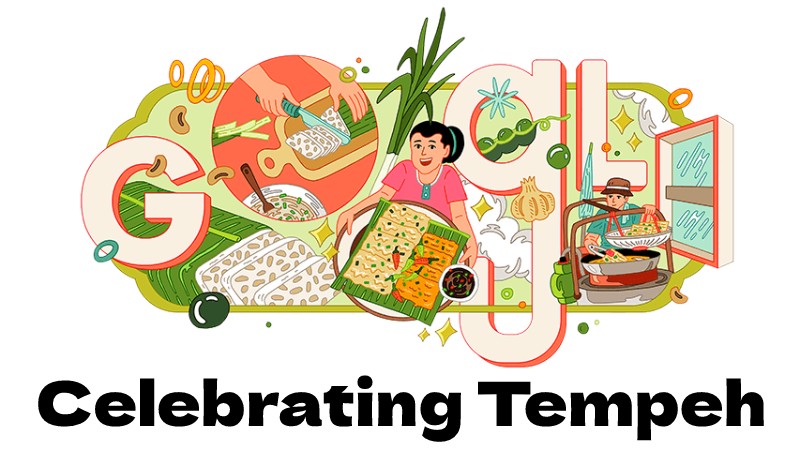Festivals & Events
Google Doodle is celebrating Tempeh, a traditional Indonesian food

Google Doodle is celebrating Tempeh, a traditional Indonesian food produced using fermented soybeans, on October 29, 2022.
What is Tempeh?
It is made by a natural culturing and controlled fermentation process that ties soybeans into a cake form. A fungus, Rhizopus oligosporus or Rhizopus oryzae, is used in the fermentation process and is otherwise called a tempeh starter.
It is particularly famous on the island of Java, where it is a staple source of protein. Like tofu, tempeh is produced using soybeans, however, it is an entire soybean product with various nutritional qualities and textural characteristics.
Tempeh’s fermentation process and its maintenance of the entire bean provide it with a higher content of protein, dietary fiber, and vitamins. It has a firm texture and an earthy flavor, which becomes more articulated as it ages.
This nutritious plant-based protein is a 400-year-old fermented food that originated in Indonesia and is ordinarily made of soybeans, yet it very well may be made of numerous different beans, grains, and legumes by a similar fermentation process.
Tempeh was first documented during the 1600s in Tembayat Village, Klaten, Central Java, Indonesia and was recorded on Serat Centhini, a twelve-volume compilation of Javanese stories and lessons, written in verse and published in 1814.
Individuals all around the world typically consume tempeh as a meat replacement, joined with rice and vegetables. It offers a variety of health benefits, such as improved gut and brain health.
Rich in nutrients like protein, fiber, prebiotics, and vitamin B12, this food made of negligibly processed soybeans is a well-known choice for the vast majority in Indonesia and arising among health enthusiasts around the world.
Different leaves can be used to wrap tempeh during fermentation. Waru, teak, and guava leaves are some of the oldest known, while the banana leaf is the most famous one in Indonesia.
There are numerous ways of consuming Tempeh, however, because of its incredible taste, ‘tempe goreng’ or fried tempeh has been the most well-known tempeh dish. Fried tempeh is normally joined with different sorts of sambal (ground and seasoned chili pepper dipping) and kecap manis (sweet soy sauce made of fermented soybean).
The term tempe is believed to be derived from the Old Javanese tumpi, a whitish food made of fried batter produced using sago or rice flour which looks like rempeyek. The historian Denys Lombard likewise recommends that it very well may be connected to a later term tape or tapai which signifies ‘fermentation’.
In the western world, tempeh is the most widely recognized spelling. This is done to keep readers from mistakenly pronouncing the word as “temp”. The primary known usage of this spelling is in an 1896 German article. Different other spellings, for example, témpé, were likewise used, yet tempeh has become the standard spelling in English since the 1960s.
Tempeh originated in Indonesia, very likely in central or east Java with an expected discovery between a few centuries ago to 1,000 years or more.
The type of soybean first used to make tempeh was the black soybean, which was a native plant. This later differed with the importation of white/yellow soybeans and the ascent of the tofu industry on the island.
The most well-known and commonly known tempeh is produced using fermented soybeans, called tempeh kedele or tempeh dele, produced using a controlled fermentation of soybeans.
On October 29, 2022, Google Doodle celebrates Tempeh and is illustrated by guest artist Reza Dwi Setyawan who is based in Semarang, Central Java, Indonesia.
Today’s Google Doodle highlights Tempeh Mendoan, one of the fried Tempeh varieties in Indonesia which is a famous part of Indonesian cuisine and was proclaimed as an Intangible Cultural Heritage on this day in 2021.
-
Health3 weeks ago
Back to Roots: Ayurveda Offers Natural Cure for Common Hair Woes
-

 Tech3 weeks ago
Tech3 weeks agoFrom Soil to Silicon: The Rise of Agriculture AI and Drone Innovations in 2025
-

 Science7 days ago
Science7 days agoJuly Full Moon 2025: Everything You Should Need to Know, When and Where to See Buck Moon
-

 Sports3 weeks ago
Sports3 weeks agoFIBA 3×3 World Cup 2025: Full Schedule, Preview, and How to Watch
-

 Gadget4 weeks ago
Gadget4 weeks agoThings to Know about Samsung Galaxy S26: What’s New and What’s Next
-

 Tech4 weeks ago
Tech4 weeks agoAdobe Firefly App Now Available on iOS and Android Phones to Create AI Images and Videos Anywhere
-

 Sports2 weeks ago
Sports2 weeks agoPrefontaine Classic 2025: Full Schedule, Preview, Field, Events and How to Watch Diamond League Eugene Live
-

 Festivals & Events4 weeks ago
Festivals & Events4 weeks agoEverything You Should Need to Know about Summer Solstice 2025

























